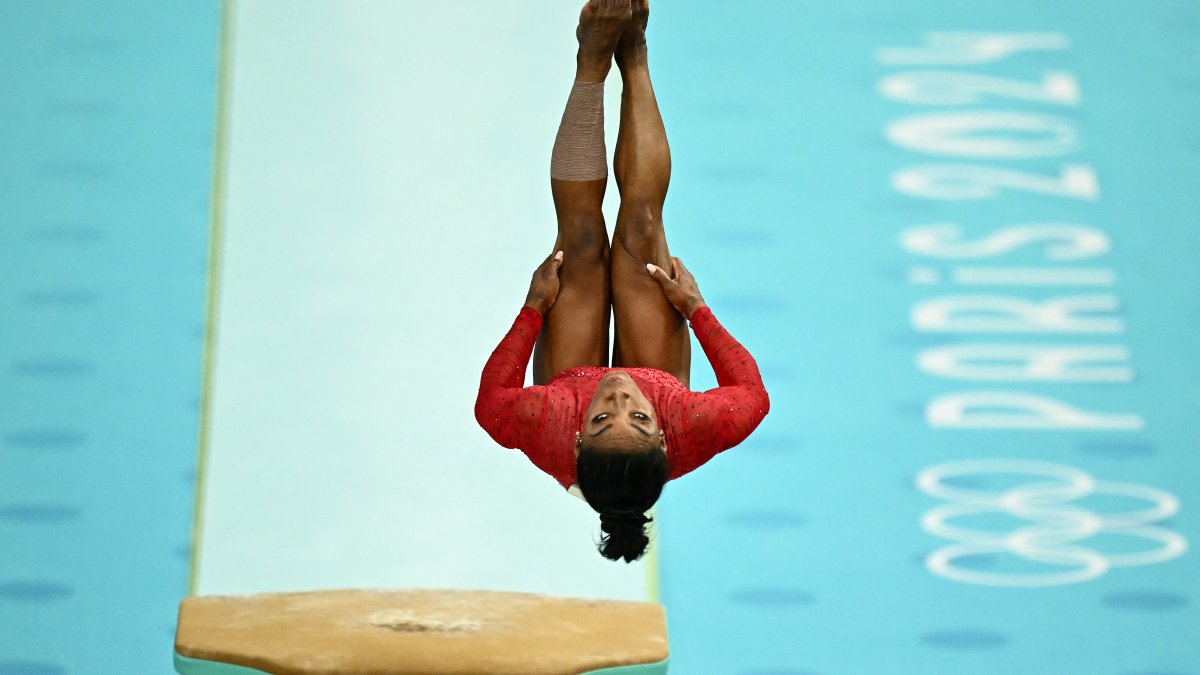Simone Biles finished the women’s gymnastics vault final with yet another gold medal — and from the moment she ended her second pass it was clear the gymnastics GOAT was untouchable on the podium.
But just how big was her score, why was it special and was it the highest score recorded on vault?
Vault is one of Biles’ best events. She has two skills named after her on the apparatus and has put up some of the highest scores at international competitions.
On Saturday, she scored an average of 15.300 for her two vaults, a rotation that included her signature Yurchenko double pike, which is the hardest being done in competition by any female gymnast.
The crowd inside a packed Bercy Arena roared when Biles was introduced. Wearing a sequined red leotard, she delivered another show-stopping performance in what could be the last vault competition of her life.
Here’s what to know about the stunning finale:
What were Simone Biles’ vault scores?
She drilled her Yurchenko double pike, exploding off the block and then flipping backward twice with her hands clasped behind her knees. She landed with a big bounce — a nod to the energy she generates — with her right foot on the out-of-bounds line.
The judges dinged her a tenth of a point for that. It hardly mattered. Her score of 15.700 meant she merely needed to avoid disaster on her second vault to win. Instead, she almost stuck her Cheng, which requires a roundoff onto the springboard, then a half twist onto the block followed by 1 1/2 twists while doing a forward somersault.
The ensuing 14.900 meant the rest of the eight-woman field was going for second.
Was it the highest score ever in Olympic vault?
No.
According to the International Gymnastics Federation, McKayla Maroney still holds the record for the highest vault total, which she scored during the U.S. women’s golden run in London.
In that routine, Maroney stuck an Amanar vault in the team final, landing a whopping 16.233.
How does gymnastics scoring work?
Nine judges are chosen to score each Olympics gymnastics event. Those judges are broken into three groups: the D panel (difficulty score), E panel (execution score) and reference panel.
Difficulty score
The D panel is made up of two judges who determine the difficulty score.
Both judges record their difficulty score, accounting for the eight most difficult skills — including dismount — for women and 10 most difficult skills for men. The D panel judges compare scores and determine the routine’s difficulty score.
Vault is the only apparatus that has a predetermined difficulty score, which is displayed to the judges before the gymnast begins their vault.
Execution score
The E panel has five judges who determine the execution score. The execution score starts at 10.0 and the E panel makes deductions for errors during the routine. Deductions range in value from 0.1 to 1.0.
The five judges each record their own execution score for the routine. The top and bottom scores are dropped and the three remaining scores are averaged out to determine a final execution score.
Neutral deductions
Certain errors such as time violations, stepping out of bounds, behavior faults and falls are penalized as neutral deductions.
Inquiries
A gymnast can make a verbal challenge, called an inquiry, to the judges after their routine. The verbal inquiry must be followed by a written inquiry and can only occur after the gymnast’s final score has been posted.
Scores can be raised, lowered or remain the same based on the inquiry.
Code of Points
The Code of Points defines the scoring system for each level of gymnastics competitions.
Different gymnastics levels, disciplines and countries have their own codes. The International Gymnastics Federations sets the Code of Points for the top level of the sport, including the Paris Olympics.
Each athlete is awarded both and execution and difficulty score following their routines.
What is a perfect score in gymnastics?
According to NBC Olympics, there is no more “Perfect 10” in gymnastics, but gymnasts can still reach a perfect score — there is just no number associated with it.
“Now, a perfect score for a gymnast would be receiving no deductions from the judges, while also completing their planned routine with full difficulty. Under the open-ended scoring system, no gymnast has received a perfect score,” NBC Olympics reported.
